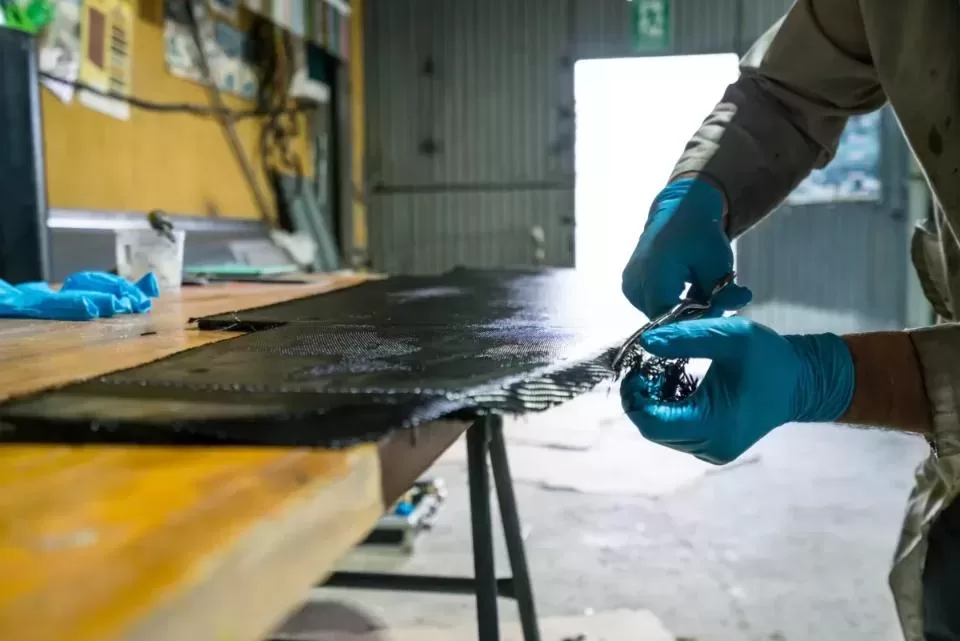
Carbon fibre reinforced plastics (CFRPs) are a type of composite material made from carbon filaments that are usually woven into a fabric and then impregnated with a polymer resin. When the resin cures, the material develops the properties it is known for, like its high strength-to-weight ratio, durability, and resistance to corrosion, which make it an attractive material for a wide range of applications, including the marine sector.
The use of carbon fibre in the marine industry has gained interest in recent years due to its potential to revolutionise boat design and construction. Its lightweight and strong properties can provide a number of benefits, including increased speed and fuel efficiency, improved stability and handling, and reduced emissions. As the demand for high-performance and sustainable boats continues to grow, the use of carbon fibre in the marine sector has the potential to become widespread.
Advantages of using carbon fibre in boats
One of the major advantages of using carbon fibre in boat construction is its lightweight properties. Unlike traditional materials such as fibreglass or steel, carbon fibre is much lighter and therefore can result in significant weight savings for the boat. This reduction in weight can improve the performance and manoeuvrability of the boat, as well as increase fuel efficiency and reduce emissions. Additionally, lighter boats are easier to handle and transport when out of the water, making them more convenient for owners and operators who store their boats on land or transport them between different bodies of water.
The customisability of carbon fibre is another advantage that makes it appealing for use in boat construction. Carbon fibre can be moulded and shaped into virtually any form, allowing boat builders to create custom designs and shapes that would be difficult with other materials. This gives boat builders the choice to improve performance. Additionally, this design flexibility allows for the creation of boats with unique and innovative designs, which can appeal to a wide range of customers and set a boat apart in the market.
How is carbon fibre used in boats?
Carbon fibres are used in boats for a variety of applications, from structural components to decorative elements. One of the primary uses of carbon fibres in boat construction is for structural reinforcement. Carbon fibre’s high strength-to-weight ratio makes it an ideal material for building lightweight yet strong structures, such as boat hulls and decks. By using carbon fibre in these critical areas, boat builders can achieve significant weight savings without sacrificing strength or durability.
In addition to structural reinforcement, carbon fibres can also be used for decorative purposes in boats. The unique appearance of carbon fibre, with its distinctive weave pattern, can be used to add a modern, high-tech aesthetic to a boat’s design. This can include accents such as trim pieces or dashboards, or even entire sections of the boat’s interior or exterior. The versatility of carbon fibre allows boat builders to incorporate it into their designs in a variety of ways, and the resulting boats can be both functional and visually striking.
How does carbon fibre impact the performance of different types of boats?
Carbon fibre has revolutionised the performance of boats by providing designers and engineers with a lightweight, strong, and rigid material that allows them to push the boundaries of speed, efficiency, and manoeuvrability. For example, in sailing vessels, the use of carbon fibre has allowed for the construction of better sails, by increasing strength and reducing weight. Using CFRPs also reduces the total weight of sailing vessels, resulting in faster sailing speeds and improved handling in a wide range of wind and sea conditions.
In motorboats, the use of carbon fibre has led to significant improvements in performance, particularly in terms of speed and fuel efficiency. The lightweight and strong material allows for the construction of hulls and decks that are thinner, yet more rigid, resulting in less drag in the water and improved acceleration. Additionally, the use of carbon fibre can reduce the overall weight of the boat, which in turn can lead to improved fuel economy and range. In high-speed racing boats, the use of carbon fibre has allowed for the construction of boats that can reach astonishing speeds while still maintaining control and stability.
Carbon fibres may have the greatest impact on regular people’s lives when they are used in larger passenger vessels, like ferries. The lightweight nature of carbon fibre reduces the overall weight of the ferry when used in heavy structural components, allowing for increased passenger and cargo capacity, while maintaining speed and fuel efficiency. Additionally, the increased strength and durability of carbon fibre allow for the construction of larger and more complex designs, such as high-speed catamarans, which can carry more passengers and cargo, and provide a more comfortable and enjoyable ride. You may even find yourself commuting on electric hydrofoils at high speed in the near future, thanks to carbon fibre.
What is the future of carbon fibre boats?
The future outlook for carbon fibre in the marine industry is bright, as the material continues to play a key role in the development of new and innovative boats. The weight reductions and design improvements that carbon fibre enable will only become more important, as local and global environmental concerns drive the ever-increasing need for emissions reductions.
Another area of innovation in the use of carbon fibre in the marine industry is the development of more advanced manufacturing techniques. These include methods such as 3D printing and automated layup processes, which allow for greater precision and control in the construction of boats. These technologies are expected to play an important role in the future of boat building, as they enable faster, more efficient, and more cost-effective production of carbon fibre components.
Finally, the future of carbon fibre in the marine industry is likely to be driven by ongoing research and development efforts. This includes efforts to develop new types of carbon fibre that are even stronger and lighter than existing types, as well as research into new applications and uses for carbon fibre in boat construction. With continued investment in R&D, the future of carbon fibre in the marine industry is likely to be filled with exciting new developments and innovations that will push the boundaries of what is possible in boat design and engineering.

